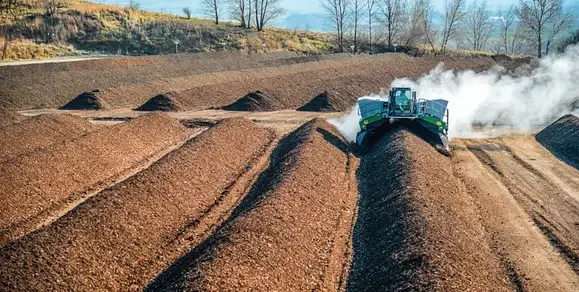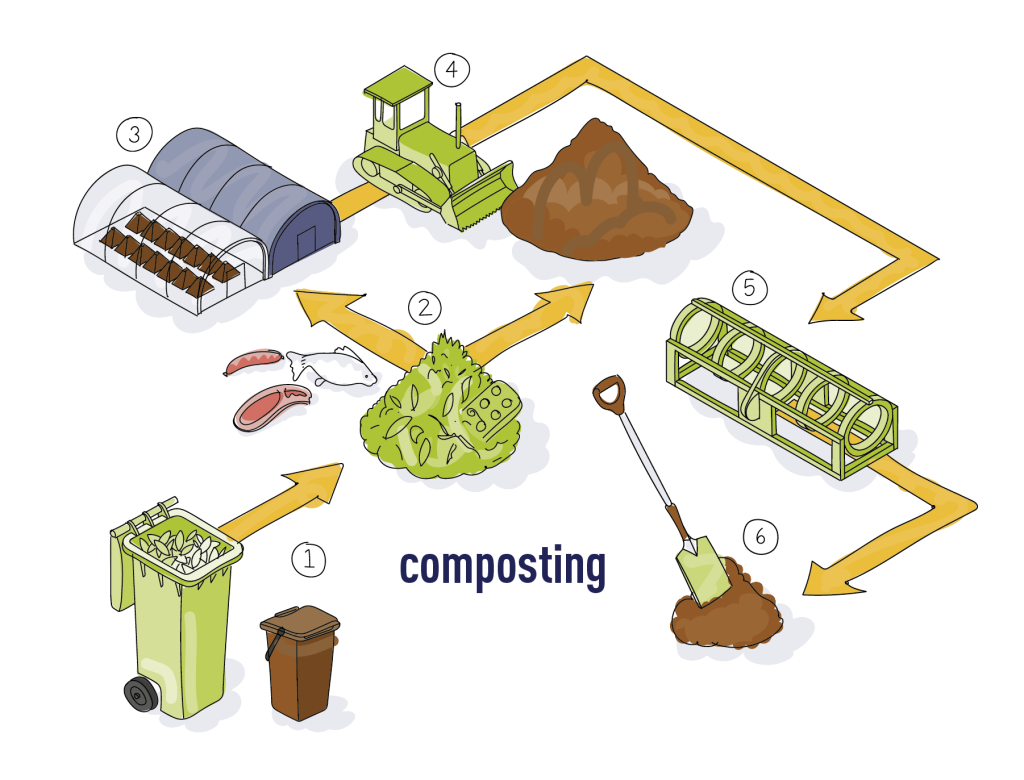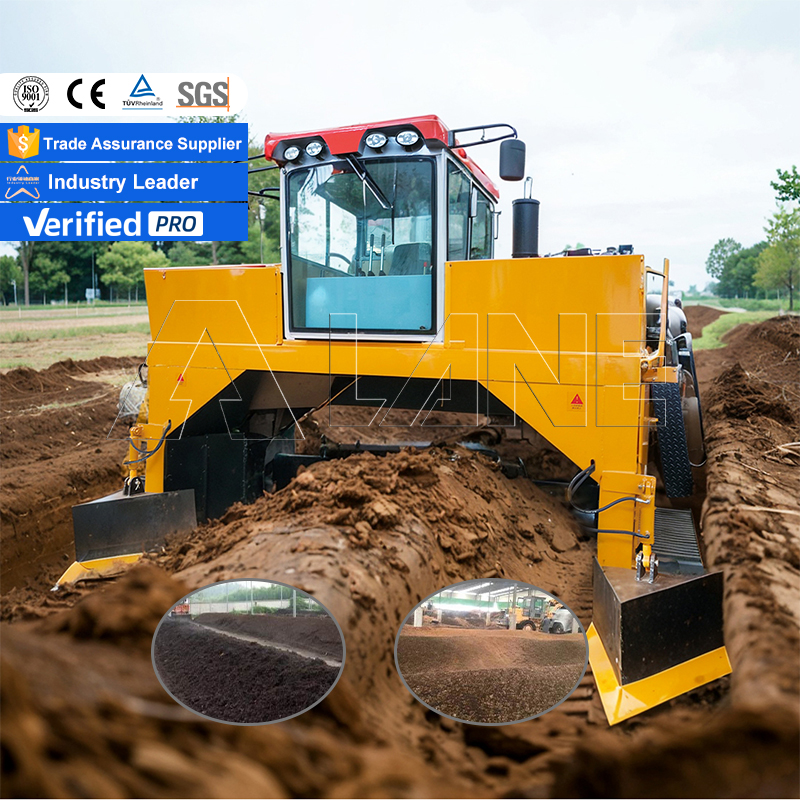Commercial compost production is at the forefront of sustainable waste management, transforming organic waste into valuable soil amendments. Whether you’re considering starting a compost production facility or a seasoned compost producer, it’s essential to understand what the process entails, its benefits to both business and the environment, and the various equipment options available for the most effective operations.

In today’s world, where planet health matters more than ever, commercial compost production is becoming an essential move for many businesses. Commercial composting is not only crucial for mitigating climate change impacts but also offers substantial financial benefits for businesses. Composting businesses can attract eco-conscious consumers, gain a competitive edge, and gain a robust market share. This approach not only helps elevate standards in waste industry leadership but also opens up lucrative opportunities in the growing green economy.

1.Collection and Preparation: Organic waste materials are collected and often pre-processed to remove contaminants and reduce particle size for enhanced microbial activity.
2.Active Composting: Various “recipes” of the prepared waste are then mixed and subjected to conditions that encourage aerobic decomposition by microorganisms. This phase is characterized by high temperatures that reduce pathogens and weed seeds.
3.Curing: Following active composting, the material undergoes a curing phase where microbial activity slows, and the compost stabilizes.
4.Screening and Packaging: The finished compost is screened to remove any remaining impurities or inorganic contaminants, including plastics, and then packaged or prepared for sale or use.
There are three ingredients needed to create compost: Nitrogen, Phosphorus, and Potassium (NPK). Together, these elements are essential for the microbial activity that accelerates the decomposition of organic matter. Raw organic materials used in commercial composting are known as feedstocks, and they typically include varieties of food waste and scraps, yard waste and trimmings, manure, and agricultural residues. These materials are rich in carbon and nitrogen, the fundamental elements for microbial activity.
The ideal ingredient mix usually varies from compost producer to compost producer. However, successful “recipes” consist of an optimal balance of carbon-rich materials, such as leaves and woody materials, with nitrogen-rich materials, like food scraps and grass clippings, to optimize the composting process.
Commercial composting is typically categorized into three primary production methods, each with its unique process. Understanding these methods is crucial for businesses aiming to select the most efficient and effective composting approach for their needs.
Static pile composting entails placing organic waste in large piles, where it remains stationary throughout the decomposition process. This method is often utilized for materials that decompose slowly or when space constraints exist. In order to ensure adequate oxygenation, piles are equipped with a series of ventilation pipes in the floor beneath the piles. These pipes allow air to flow into the pile, eliminating the need for frequent turning. This approach can be cost-effective due to minimal labor and equipment needed but also requires constant careful monitoring to maintain optimal conditions for composting.
In-vessel composting represents the most controlled commercial composting method, with organic waste decomposing inside a closed container. This method allows for precise control over temperature, moisture, and aeration, ensuring rapid decomposition of the waste material. In-vessel systems can vary in size, from small drums to large industrial-scale reactors, accommodating different volumes of waste. This approach is ideal for urban areas or environments where space is limited, as it minimizes odors and pest attraction. In-vessel composting involves higher initial capital and operational costs but does provide quick turnaround times from waste to usable compost.
Windrow composting is the process of piling organic waste into long, narrow-rowed piles. This method is favored for its adaptability to various types of organic materials and scalability. The windrows are regularly turned to introduce oxygen to the pile, which is crucial for aerobic decomposition. The turning process also helps to evenly distribute heat, moisture, and microorganisms throughout the pile. Windrow composting is particularly effective for handling large volumes of organic waste and is commonly used in agricultural and municipal operations. It requires a space footprint large enough to house the windrows and the use of specialized machinery equipment called windrow turners to perform the periodic turning.
Each composting approach has its advantages and ideal use scenarios, dependent on the specific requirements and constraints of the composting operation. By carefully evaluating the types and volumes of organic waste, along with space, labor, and capital investment considerations, businesses can select the most appropriate commercial composting method to optimize their sustainability efforts and financial return.
For businesses venturing into organic waste recycling, commercial composting presents a unique opportunity to achieve significant environmental and economic benefits. This process not only supports sustainable waste management by diverting organic waste from landfills, thereby reducing greenhouse gas emissions, but it also transforms waste into a valuable product that can generate revenue.
1.Environmental Impact: By diverting organic waste from landfills, composting significantly reduces methane emissions, a potent greenhouse gas. Furthermore, compost used in agriculture and landscaping conserves water and reduces the need for chemical fertilizers by using a nutrient-rich soil amendment instead.
2.Economic Advantages: Commercial composting can transform organic waste management from a cost center into a revenue stream through the sale of valuable, marketable compost products. It also saves money on landfill hauling and tipping fees while contributing to a circular economy.
3.Soil and Plant Health: Compost improves soil structure, enhances water retention, and provides essential nutrients to plants, supporting sustainable agricultural and landscaping practices.
The scale and nature of commercial composting operations dictate the type of equipment required.
1.Shredders and Grinders: High-speed grinders and low-speed shredders both reduce the size of organic waste, making it more suitable for composting and microbial activity, especially in windrow composting.
2.Windrow Turners: These machines aerate compost piles, ensuring oxygen is distributed evenly throughout the material, heat is dissipated, and adequate aerobic conditions are maintained.

3.Screening Equipment: Screeners, whether trommel or star screen, are used to separate unfinished compost or large particles from the finished product, ensuring quality and uniformity. Star screens are engineered to process compost, even with wet or moist material, efficiently.
4.Separating Equipment: Windsifter separators are used to separate lightweight contaminants, like film plastics, from the finished compost, ensuring clean end products.
5.Temperature and Moisture Sensors: Monitoring equipment is crucial for optimizing composting conditions and achieving high-quality compost.
Commercial composting is a powerful tool for businesses to achieve economic benefits while promoting environmental protection. By understanding the nuances of the composting process, the materials involved, and the equipment required, one can effectively integrate composting into their operations. As the demand for sustainable practices continues to grow, commercial composting is expected to play a key role in shaping a more resilient and circular economy.
Want to learn more about commercial composting? Click here to speak with one of our organic waste recycling experts.